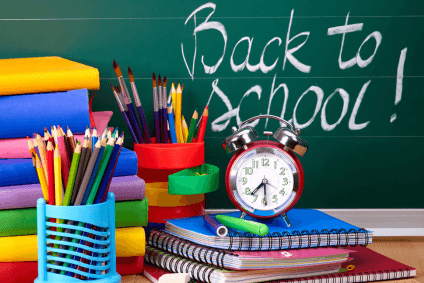Avoid a Back-to-School Breakdown
How to successfully transition from summertime to school-time.
For many of you, summer is drawing to a close. You’re bracing yourself for the end of summer, while children seek out their last few days home. Some of you may already have returned to the busy routine of sack lunches and school buses.
Regardless, this time of year can be stressful. There seems to be more to do than there is time in the day, and it can be hard to part with your child after having them home all summer. Young learners pick up on this, and they often approach the beginning of the school year with mixed emotions. If your child is back in the classroom, you may have already noticed some anxiety on their part.
Whether you’re kissing your child goodbye at the bus stop or still hunting down the perfect lunch box, I’ve been there. Every year I face the same stressors, and I implement new tactics to make it easier. Today I want to share with you my three top tips to making a successful transition from summertime to school-time (for everyone involved).
Ease back into a routine
There’s a good chance your summer routine is drastically different from your school-year routine, and the same goes for young children. Summertime tends to be less structured and the activities tend to be less academic in nature. Even if a child spends ample time engaged in critical thinking activities, there’s a good chance they were formatted differently from those during the school year.
Because of this, it’s important to slowly ease back into the school-year routine. Take time to practice waking up and going to bed earlier, and begin organizing your day around a more structured schedule. Your mind and body will both thank you.
This is also a good time to create systems of organization around the school year. Reflect on the previous year and think about how you could better arrange your day. Decide on a few small modifications that will help you stay on top of all your responsibilities.
Create an atmosphere of excitement
So often the idea of returning to school is met with groans of unhappiness instead of anticipation. To help young learners reclaim their excitement, emphasize the amount of fun they will have. As a parent, take time to integrate learning games into the day, so students are already accustomed to the practice.
If you’re a teacher, integrating ample play time that allows for critical thinking practice will help students look forward to their time in your classroom. Not only that, but students who play more are given a chance to discover more. They internalize concepts through the act of playing, and are able to naturally investigate a wide variety of concepts.
Give students a say
It can be easy for children to feel as if they have no control over their life, especially in the beginning of the school year. They’re being told where to go, what to learn, and how to spend their time. Often they are limited in the amount of discovery time they have, and as a result, it becomes difficult for them to take ownership of their learning.
To resolve this, make a habit of asking young learners open-ended questions. Give them opportunities to make small decisions, such as which backpack to buy or what game to play, in a structured environment. Parents and teachers both can practice this, and will find that engaging students in conversation rather than simply issuing demands actually makes them more efficient learners.
Don’t forget to have fun! Your attitude is contagious.
If you’re miserable, odds are your students or children will pick up on it. So as you settle into a new school year, keep your own mood in mind. By settling slowly into a routine, making school something to anticipate excitedly, and giving students a say in what happens you’re setting the stage for an exciting school year.
What are you most looking forward to this year?



